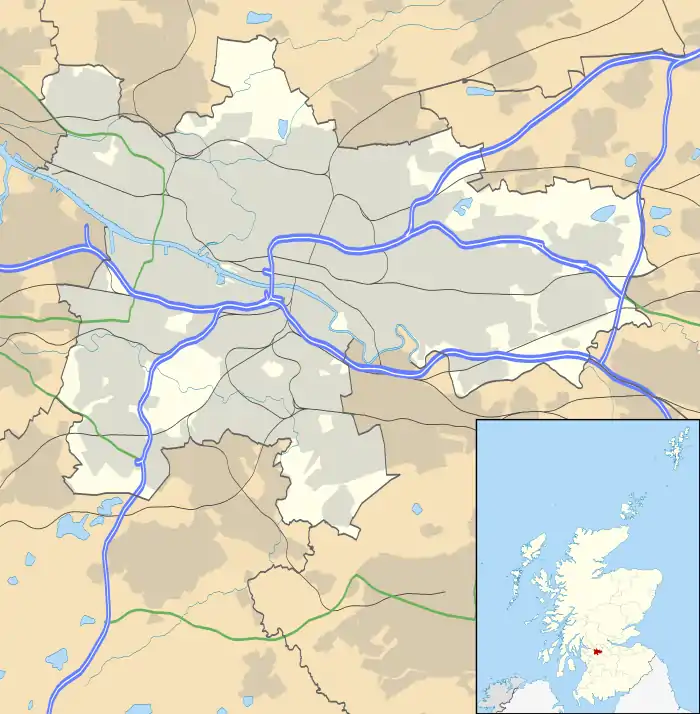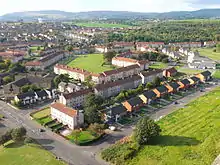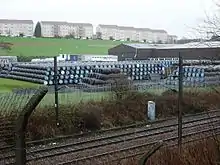Drumchapel
Drumchapel (Scottish Gaelic: Druim a' Chapaill), known to locals and residents as 'The Drum', is part of the city of Glasgow, Scotland, having been annexed from Dunbartonshire in 1938. It borders Bearsden to the east (in East Dunbartonshire) and Clydebank to the west (in West Dunbartonshire). The area is bordered by Knightswood and Yoker in Glasgow. The name derives from the Gaelic meaning 'the ridge of the horse'.
Drumchapel
| |
|---|---|
.jpg.webp) Aerial view of central Drumchapel (2017), with the local secondary school surrounded by expanses of unused land following the demolition of substandard housing, with modern houses and refurbished tenements also in view | |
 Drumchapel Location within Glasgow | |
| Population | 12,976 |
| OS grid reference | NS525705 |
| Council area | |
| Lieutenancy area |
|
| Country | Scotland |
| Sovereign state | United Kingdom |
| Post town | GLASGOW |
| Postcode district | G15 |
| Dialling code | 0141 |
| Police | Scotland |
| Fire | Scottish |
| Ambulance | Scottish |
| UK Parliament | |
| Scottish Parliament | |
As part of the overspill policy of Glasgow Corporation, a huge housing estate was built here in the 1950s to house 34,000 people – it is this estate that is now most associated with Drumchapel, despite there being an area known as Old Drumchapel made up of affluent villas to the south of modern Drumchapel.
The area had well-known social problems, notably anti-social behaviour and degeneration of often poorly constructed post-war housing. However, it remains popular with many of its residents and more recently there has been substantial private investment in the area, leading to the construction of new housing developments in the north-west of the district. The area, along with Easterhouse, Castlemilk and Greater Pollok, are collectively known as 'Big Four' post-war social housing schemes. All are similar in terms of architecture and planning, and tend to suffer from a similar range of social problems.
The area is served by Drumchapel railway station.
History

Drumchapel was part of the parish of New Kilpatrick, becoming devolved in the late 19th century and a church parish in its own right in 1923. The Old Church (originally serving both Drumchapel and Blairdardie) was built in 1901 for an increasing local population.[1] The parish boundary was redrawn to create the new parish of St Margarets in Knightswood.[2]
Civil administration transferred from New Kilpatrick to Glasgow Corporation in 1938. As part of the overspill policy of Glasgow Corporation, a huge housing estate was built here in the 1950s.[3][4]
The area suffered a tragedy in 1994 when a double-decker bus carrying a group of local Girl Guides crashed into one of the low rail bridges in the city's Tradeston area (the driver was unfamiliar with the route and was being led by a guide leader in a car); two 10-year-old girls, an 11-year-old girl and two adult supervisors were killed in the incident and 15 other children injured, six of them seriously.[5][6][7][8][9]
Geography

The housing in the area is now 72% post-war tenement and 6% multi-storey flats, the remainder being other flats and houses. The current population was estimated in 2002 at 15,000, which was split across 6,000 households.[10] The population of Drumchapel fell by 22% between 1996 and 2012 to 13,000. The proportion of people in the area from ethnic minority groups increased over the same time to 5%, which remains well below average for Glasgow (12%). Life expectancy in the area is about five years less than the average for Glasgow (male 69 years, female 74 years).[11]
Socio-economically, the area is not affluent. In 2011/12, 48% of children were classed as living in poverty, and 57% of the population were NRS social grade D or E. 56% of households were single-parent. 21% of young people were not in education, employment or training. Just 22% of the population own their own home, about half the average figure for Glasgow.[11]
Economy

The major employers for Drumchapel from the 1950s to the 1980s were the Goodyear Tyre & Rubber Co (GB) Ltd, Beattie's Biscuit Factory, Singers Sewing Machines (Clydebank), The Reo Stakis Organisation – Hills Hotel and Rigg Public Bar, The Golden Garter Night Club and The Butty Public Bar, The Edrington Group Whisky Bond and the various shipyards on the Clyde. Beattie's Biscuit factory closed in 1978 and the Goodyear and Singers factories both closed in February 1979. Reo Stakis's Hills Hotel and Rigg Public Bar along with The Golden Garter Night Club closed in June 1988.

The Butty Public Bar was sold to Scottish & Newcastle Breweries and is still going strong with Billy Bryson, the manager for over 30 years, now holding the lease. The Edrington Group Whisky Bond has grown over the years and is still a major employer in the area, while the shipyards have all gone with the exception of the now BAE Systems yards at Scotstoun and Govan. Drumchapel is now going through its second regeneration, with promises of better schools, better homes and higher employment.[12]
See also
References
- Kilpatrick Parish Archived 10 May 2010 at the Wayback Machine
- McCardel, J (1949). The Parish of New Kilpatrick. University Press Glasgow.
- Drumchapel, 1954, Virtual Mitchell
- Modern Times: 1950s to The Present Day: Neighbourhoods: Drumchapel, The Glasgow Story
- Bus crash toll rises to five as girl dies, The Herald, 28 September 1994
- Anger at verdict over Guides death crash, The Independent, 22 March 1995
- I still blame myself for Cath's death | Tormented bus crash victim's mum tells court of agony, Daily Record, 21 October 1998, via thefreelibrary
- Drumchapel Girl Guides tragedy remembered 20 years on, Clydebank Post, 24 September 2014
- Judgement| Joseph Munro McKnight and Mrs Joan McKnight v. Clydeside Buses Limited and Glasgow City Council and Railtrack Plc and Mima Dunlop, Scottish Courts Service, 23 December 1998
- Glasgow City Council: Drumchapel Area Housing Plan 2002
- "Drumchapel". Understanding Glasgow. Glasgow Centre for Population Health. Retrieved 16 March 2015.
- The History of Drumchapel Archived 4 June 2007 at the Wayback Machine
External links
| Wikimedia Commons has media related to Drumchapel. |
- Glasgow West Regeneration Area
- Housing Regeneration Article
- Overspill Policy and the Glasgow Slum Clearance Project in the Twentieth Century: From One Nightmare to Another? article by Lauren Paice, Oxford Brookes University, 2008
- Drumchapel: The Frustration Game, 1989 documentary on living conditions in the area